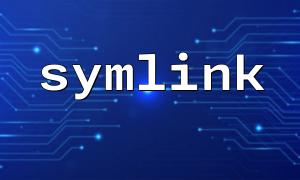In Unix-like systems such as Linux and macOS, Symbolic Link (Symbolic Link, also known as soft links) is a very useful file system function. It allows you to create shortcuts for a file or directory, allowing you to access them through another path. PHP provides a built-in function symlink() to create such links. This article will start from the basics and gradually guide you to learn how to use PHP's symlink() function to create and manage symbolic links, and provide practical examples to help you get started quickly.
A symbolic link is essentially a path reference to another file or directory. It's like a "shortcut" in Windows systems, but it's more powerful. You can use it to:
Simplify access to complex paths;
Share certain resources by multiple projects;
Create a version management structure, such as current linking to release_2025_05 ;
Redirects the file structure but does not actually copy the data.
The symlink() function in PHP is defined as follows:
bool symlink(string $target, string $link)
$target : The path to the original file or directory you want to link;
$link : The path to the symbolic link you want to create.
If true is successful, false is returned if false is failed.
Note: Using this function requires that the PHP script has sufficient file system permissions and may be disabled in some shared hosts or restricted environments.
The following example links a file /var/www/html/storage/data.json to /var/www/html/public/data.json .
<?php
$target = '/var/www/html/storage/data.json';
$link = '/var/www/html/public/data.json';
if (symlink($target, $link)) {
echo "Symbol link creation successfully";
} else {
echo "Creation failed";
}
?>
After running this script, you will find a link named data.json appears in the public directory, pointing to a file with the same name in the storage directory.
You can also create links for the entire directory in the same way:
<?php
$target = '/var/www/html/storage/';
$link = '/var/www/html/public/storage';
if (symlink($target, $link)) {
echo "目录Symbol link creation successfully";
} else {
echo "Creation failed";
}
?>
This is common in frameworks such as Laravel, such as linking the storage directory to a public directory for web access.
Imagine you have multiple versions of the release directory:
/var/www/releases/
├── v1.0.0/
├── v1.1.0/
└── v2.0.0/
You want /var/www/html/current to always point to the latest version, and you can create a link dynamically in PHP:
<?php
$newVersion = 'v2.0.0';
$target = "/var/www/releases/$newVersion";
$link = '/var/www/html/current';
if (is_link($link)) {
unlink($link); // Delete the old symbolic link first
}
if (symlink($target, $link)) {
echo "Already current Link updated to $newVersion";
} else {
echo "Update failed";
}
?>
In this way, users always get the latest deployment version when visiting gitbox.net/current .
The following problems are common when using symlink() :
The target path does not exist : make sure $target exists;
The link already exists : use file_exists() or is_link() to check;
Create links without permission : Especially in Linux, users with root or write permission may need to run PHP.
example:
<?php
$target = '/var/www/html/storage/data.json';
$link = '/var/www/html/public/data.json';
if (file_exists($link) || is_link($link)) {
echo "The link already exists,Unable to create";
} else {
if (symlink($target, $link)) {
echo "Link creation successfully";
} else {
echo "链接Creation failed,Please check permissions";
}
}
?>
PHP scripts can use ln -s in combination with shell_exec() to create links to bypass certain restrictions;
Use absolute paths to avoid symbolic link failure;
Symbol link logic can be added to the deployment script to improve automation.
PHP's symlink() function provides you with the flexibility to operate file systems, especially in terms of deployment, resource redirection, framework structure management, etc. Mastering and using it flexibly can greatly improve your back-end development efficiency. Whether it is managing large project directories or creating cross-directory access paths, symbolic links are a powerful tool. I hope that the practical examples in this article can quickly apply them in actual projects.
Let’s try it now!





